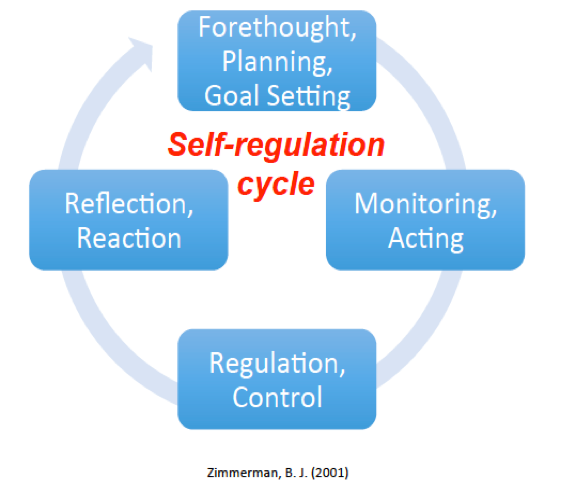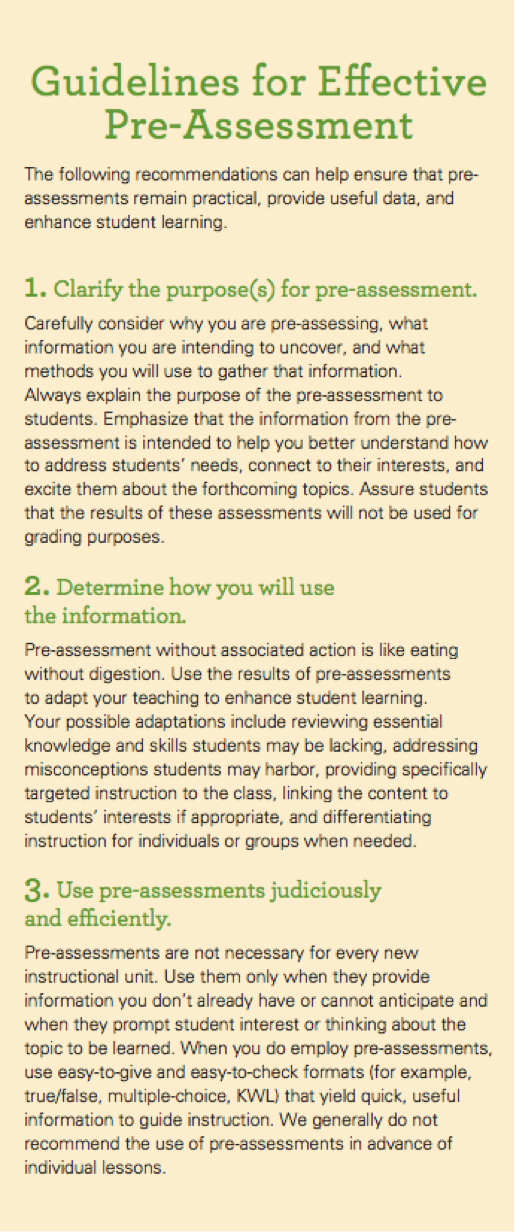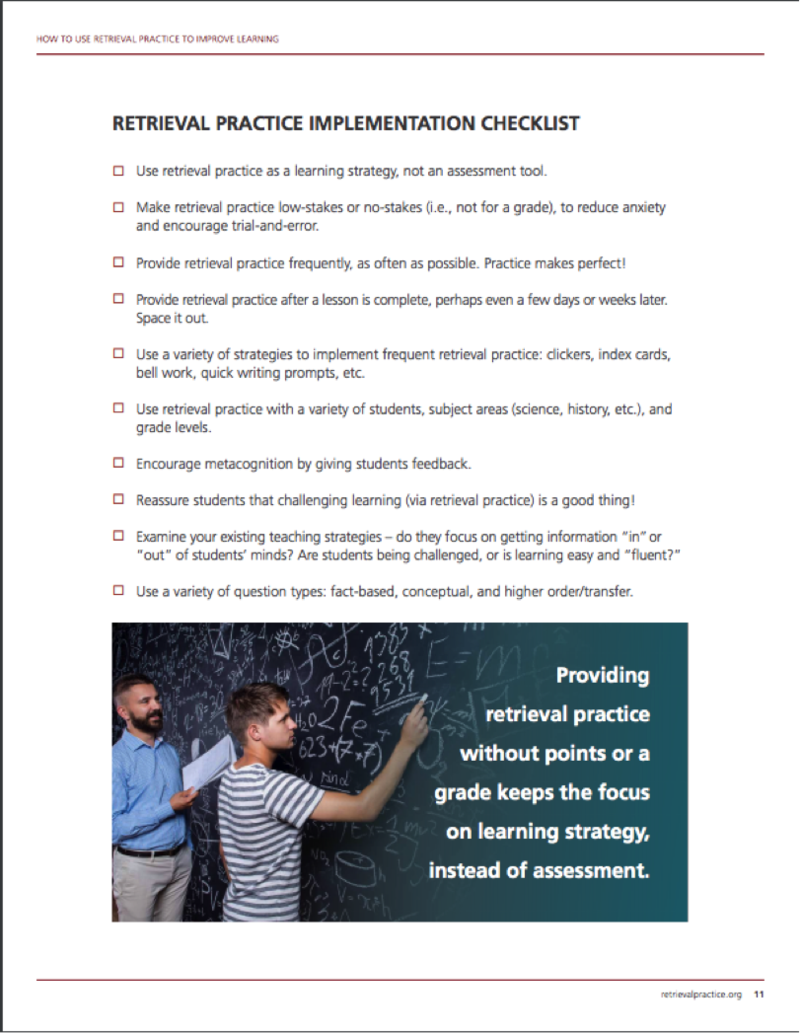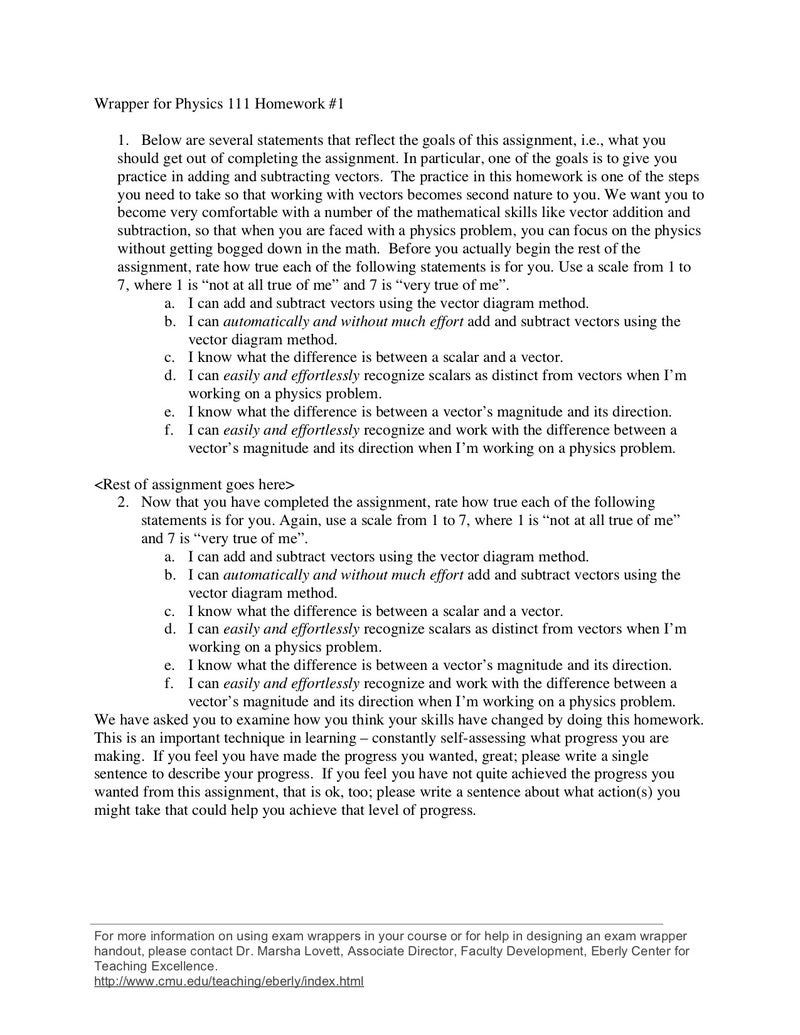Taking a Metacognitive Approach to Active Learning
Contents
Introduction
Although existing research documents the impact of active learning (Ambrose et al., 2010; Bonwell and Eison, 1991), the focus is often on collecting and implementing techniques. While it is tempting to “plug and play,” to be effective, active learning needs to be examined in the larger context of student learning (Weimer, 2018). Taking a metacognitive approach—choosing forms of active learning that foster metacognition—can help faculty prepare students to make the most of active learning experiences while helping them become self-directed learners (Pelley, 2014). This module will focus on strategies and approaches instructors can take to become more metacognitive in their own professional practice and to use metacognition as they design and implement active learning in their classes.
Objectives
After completing this module, readers will be able to:
- Describe the relationship between metacognition and active learning
- Understand several approaches to engaging students in active learning that fosters metacognition and metacognitive awareness in students
- Identify ways in which they can use metacognition to design and implement active learning in their classes
UDL Alignment
The specific metacognitive and active learning strategies highlighted in this module provide options that speak to each of the principles of UDL; however, for this module, the most salient connection is to the Multiple Means of Engagement principle.
Active learning, in general, aligns with the principle of Multiple Means of Engagement by providing students with opportunities to be involved and engaged in their own learning process (Bonwell and Eison, 1991) through the application of new information and ideas. Through this process, students begin to see the new information and ideas as connected to the real world rather than as abstractions. By intentionally adapting and incorporating active learning that also fosters metacognitive thinking and learning, instructors strengthen this alignment through the opportunities have to self-regulate. Specifically, engaging students in reflection, problem-solving, collaborative learning, and retrieval and practice, helps students to both learn actively and develop metacognitive skills and behaviors through various forms of engagement with a new concept, topic, or idea.
Instructional Practice
This module provides strategies and approaches instructors can take to design and implement active learning with the goal of fostering students’ metacognition.
What is Active Learning?
Active learning in the college classroom can take many different forms, ranging from role-playing to case studies, but ultimately, active learning involves students in doing things and thinking about the things they are doing (Bonwell and Eison, 1991). To be meaningful, active learning should involve providing students with information and ideas (context) before engaging in an active experience, and following the experience, there should be an opportunity for reflection (Fink, 2003). Some examples of active learning are considered “small teaching,” or short activities or in-class assignments (e.g., minute papers, think-pair-share, polls) that are designed with the intent to briefly engage students in reflection on a specific question or idea.

Figure 1: Sample Form: The Minute Paper, Center for the Enhancement of Learning & Teaching Retrieved from http://provost.tufts.edu/celt/files/MinutePaper.pdf
While other approaches to active learning are more significant, like the inclusion of a service learning or other forms of collaborative assignments and projects (e.g., case studies that are generated by students, etc.), and may require some level of course redesign to be intentionally integrated into the course.
This podcast featuring Dr. Peter LePage, a Physics Professor at Cornell University, provides an overview of active learning as a pedagogical practice.
Why Use It?
Active learning actively involves all students in the learning process. Rather than waiting for information to be shared by the instructor, students are seeking out, gathering, and beginning to apply new information and concepts. From a UDL perspective, active learning provides alternative options for student comprehension of information, and it can help students begin to understand the utility or “why” they are learning a particular concept or idea. In sum, active learning can produce deeper and longer lasting learning.
What is Metacognition?
Metacognition is often referred to as thinking about one’s thinking, but a more comprehensive definition of metacognition takes into account awareness of thinking and learning as well as the control necessary to make changes to the ways in which one thinks and learns (Girash, 2014). Specifically, metacognition involves becoming aware of and taking control of one’s knowledge and understanding. In other words, students who are metacognitive are aware of gaps in their understanding and they are willing to seek out resources or strategies that will help them fill these gaps. Metacognitive students are also more likely to plan, monitor, and evaluate strategies they use to learn and they adapt these strategies based on the specific learning environment and/or subject (Steiner and Foote, 2017). From a UDL perspective, metacognition helps students of all identities develop strategies for self-assessment and reflection that they can then use to adapt their approaches to learning depending on the context. There are a variety of ways instructors can help students become metacognitive, including, incorporating reflection into assignments and activities through the use of written or verbal prompts.
How Does it Work?
This section will describe three different examples of approaches instructors can use to develop, design, and implement active learning that helps students become metacognitive learners.
Metacognitive Teaching – Reflecting on Our Teaching Practice
To help students become metacognitive learners, instructors should first consider their own metacognition and the role that plays in their courses. For example, we can use the following phases of the self-regulated learning cycle (Zimmerman, 2001) to examine the different aspects of our courses:
- Planning – As we plan our course and our individual class meetings for the semester, we might consider the following planning questions:
- What are my goals for this course, for each specific class meeting?
- What do my students already know about this topic, concept, or idea?
- What evidence do I have that they know a particular topic, concept, or idea?
- Monitoring – As the semester progresses and we are observing how our students are interacting with the information and ideas in the course, we might consider the following monitoring questions:
- What type of reactions did I observe in my class when I introduced this concept?
- How did those reactions change as students engaged more with the concept?
- What, specifically, helped change their perceptions of the topic, concept, or idea?
- Evaluating/Reflecting – As we are reflecting on how well a concept, idea, or theory was presented in class or the overall “success” of the course, we can consider the following evaluation/reflection questions:
- How did the class session go?
- What would I do the same and what would I do differently the next time I introduce this particular topic, concept, or idea?
- Do I have student feedback that I might use to make changes to my approach?
Reflecting on these questions and gathering evidence (e.g., student surveys or course evaluations, peer observations of teaching) that helps support or challenge our assumptions about how aspects of the course content and instructional choices are received is essential to becoming more metacognitive in our own teaching practice. Maintaining a teaching journal is a good way to capture these reflections throughout the semester. Actively reflecting on our teaching helps us hone our own metacognition and allows us to model to our students how they can integrate this into their own daily practice.

Figure 2: Self Regulation Cycle
Before, During, and After Class Metacognitive Activities
There are a variety of before, during, and after class activities and assignments that reinforce aspects of UDL, particularly around optimizing motivation for students of all identities, and can be incorporated into any course, to help students practice and strengthen their personal metacognition, including:
- Pre-assessments to prompt examination of initial thinking Activities or assignments that help students begin to think about a concept or idea and what they know about it before they are formally introduced to it (see fig. 3 for Guidelines for Effective Pre-Assessment).

Figure 3: Guidelines for Effective Pre-Assessment
- Instructor modeling (metacognitive prompting, retrieval practice- see for implementation checklist) – The use of frameworks and prompts to help students retrieve information and begin to organization make connections between a new concept and something they already know.

Figure 5: Retrieval Practice Implementation Checklist, pg. 11 ofhttp://pdf.retrievalpractice.org/RetrievalPracticeGuide.pdf
- Reflective journals, in different modalities, for self-monitoring – Journals that provide students to reflect on their learning progress with the goal of self-monitoring progress and their learning process.
- Integration of reflection into credited course work – The incorporation of reflection into an assignment or activity to allow students to think about the process by which they completed the assignment or activity, what they learned, what they might do differently next time, etc.
- Additionally, there are “Just in Time Teaching” (JiTT) strategies that can easily be incorporated into any course. Following are three examples of JiTT strategies:
- WarmUps – WarmUps involve asking students to respond to a few questions online before a class meeting (“What do you know about _____?”). The objective of this activity is to prompt students to be ready to engage in class, but at the same time, the student responses to the online questions help instructors gauge students’ understanding of a topic, concept, or idea.
- GoodFors – These are short online writing assignments, that are completed before class, that ask students to relate a topic, concept, or idea to the real world (“What is ____ good for?”). This activity can help students begin to see a personal connection to what they are learning in the course, and at the same time, this activity helps them be prepared to talk about the concept or idea in class. This website provides various disciplinary examples of GoodFors, as well as other JiTT activities.
- Peer Instruction – There are several different approaches to incorporating peer instruction into the classroom and all can help reduce barriers for students. One approach involves periodically stopping the class instruction to ask students to work through a problem or situation where they are essentially applying the concept while interacting with their peers. Students can take turns serving as the lead or expert. A variation of peer instruction is note-taking pairs. To engage students in note-taking pairs, periodically interrupt a class lecture to ask students to compare their notes with those of a classmate. Next, encourage students to talk about both the content and the format of their notes. Finally, ask for volunteers to show (and discuss the merits of) different note-taking approaches.
Debunking Misconceptions About Learning
Often, students enter our classes with misconceptions about learning and the learning process. For example, first-year students, in particular, might think they can use the same strategies they used in high school in their college-level classes, or they might think they can use the same strategies and approaches in all of their courses. Receiving a grade on a first exam or assignment can be a wake-up call, so to speak, but before that time, there are strategies we can use to help students become familiar with their own misconceptions, and at the same time, inspire them to use metacognitive strategies. Furthermore, these strategies provide multiple means of engagement, which can help all students to become more purposeful and motivated to learn.
First, the How to Study Video Series, featuring Dr. Stephen Chew, includes six short videos that explore aspects of the learning process, beginning with “Developing a Mindset for Successful Learning.” Many of the videos focus on metacognitive strategies and can be linked in course sites or even shown during class regardless of discipline. For example, an instructor in any introductory course could use these videos to help students understand the differences associated with learning at the college-level and be prepared to learn in that particular class.
Next, we can help students understand and be prepared for the learning process by engaging them in reflection on things they have learned previously in life. For example, asking students to reflect on the process they took to learn to do something that they now love (e.g., painting, singing, writing, playing a sport, etc.) and deconstructing that process (“What did it look like the first time you picked up a guitar? Did you immediately know how to play that instrument? Did you know how to read music?”) can help remind students that deliberate practice is essential to the learning process. This type of exercise can also help students develop a growth mindset or willingness and ability to see themselves as capable of learning something new or even something that they may not have had luck learning previously, which from a UDL perspective, speaks to optimizing motivation.
Finally, incorporating exam or assignment wrappers can help students to practice the type of self-reflection necessary to become a metacognitive learner (see figures 5 & 6 for exam and assignment wrapper examples). Exam and assignment wrappers are completed immediately after a student submits an exam or assignment, and they ask students to reflect on what, specifically, they did to prepare for the exam or assignment, how much time they dedicated to studying or completing the assignment, what they would do differently or the same in preparation for the next assignment or exam, and what they predict their grade will be on the exam or assignment. Wrappers are often returned to students just before they take their next exam or complete the next assignment.

Figure 6: Chemistry Exam Wrapper Example, Retrieved from https://www.cmu.edu/teaching/designteach/teach/examwrappers/

Figure 7: Physics Homework Wrapper Example, Retrieved from https://www.cmu.edu/teaching/designteach/teach/examwrappers/
Learn More
Active learning has become a “buzzword” (Eyler, 2018) in higher education, and while engaging students in active learning can result in deeper and more meaningful learning and engagement with a concept, topic, or idea (Bonwell and Eison, 1991), simply collecting and implementing active learning strategies and techniques is not enough to foster deep learning. To be effective, these practices must be intentional and connected to the course curriculum and objectives. As Weimer (2018) said, “Teaching techniques are an essential part of any active learning endeavor. But they aren’t the center or most important part of the student learning experience. Techniques provide the framework, the structure, the context. What really matters is what we put in the structure—what students are thinking about and sharing” (para 3).
Furthermore, to be most effective, instructors need to consider active learning approaches that “are most aligned with and responsive to the ways in which people actually learn” (Eyler, 2018, para 5) because those will ultimately result in the greatest gains in learning. Choosing metacognitive approaches that are also examples of active learning, provide a greater possibility of learning gains. Metacognitive approaches to active learning can be adapted and incorporated into virtually any course, and in doing so, instructors provide learning opportunities for all students.
To be intentional about metacognitive strategies that will have the greatest impact on student learning, instructors should first examine their teaching practice through a metacognitive lens, as suggested in this module. Next, instructors should consider how they help students begin to develop metacognitive skills and behaviors through activities and assignments, like those described in this module, and engage students in retrieval and reflection before, during, and after class. Finally, instructors should consider the ways they can engage students that both debunk misconceptions about learning and inspire them to use metacognitive skills and behaviors.
References & Resources
Ambrose, S. A., Bridges, M. W., DiPietro, M., Lovett, M. C., & Norman, M. K. (2010). How learning works: Seven research-based principles for smart teaching. San Francisco: Jossey-Bass.
Bonwell, C. C., & Eison, J. A. (1991). Active learning: Creating excitement in the classroom (ASHE-ERIC Higher Education Report No. 1). Washington, DC: The George Washington University, School of Education and Human Development.
Eyler. J. (2018). Active learning has become a buzzword and why that matters. Retrieved from http://cte.rice.edu/blogarchive/2018/7/16/active-learning-has-become-a-buzz-word
Fink, L. D. (2003). Creating significant learning experiences. San Francisco: Jossey-Bass.
Girash, J. (2014). Metacognition and instruction. In V. A. Benassi, C. E. Overson, & C. M. Hakala (Eds.). Applying science of learning in education: Infusing psychological science into the curriculum.
Pelley, J. (2014). Making active learning effective. Medical Science Educator, 24(1), 13-18.
McCormick, C. B. (2003). Metacognition and learning. In I. B. Weiner (Ed.), Handbook for psychology. Wiley Online.
Mcdaniel, R. (2013). Making student thinking visible: Metacognitive practices in the classroom. Retrieved from https://cft.vanderbilt.edu/2013/03/making-student-thinking-visible-the-impact-of-metacognitive-practice-in-the-classroom/
Sarkisian, E. (1997). Working in groups: A note to faculty and a quick guide for students. Retrieved from http://bokcenter.harvard.edu/fs/html/icb.topic58474/wigintro.html
Schraw, G., & Moshman, D. (1995). Metacognitive theories. Educational Psychology Review, 7(4), 351-371.
Steiner, H. H., & Foote, S. M. (2017). Using metacognition to reframe our thinking about learning styles. Faculty Focus. Retrieved from https://www.facultyfocus.com/articles/teaching-and-learning/using-metacognition-reframe-thinking-learning-styles/
Weimer, M. (2018). Deeper thinking about active learning. Faculty Focus. Retrieved from https://www.facultyfocus.com/articles/teaching-professor-blog/deeper-thinking-active-learning/
Zimmerman, B. J. (2001). Theories of self-regulated learning and academic achievement: An overview and analysis. In B. J. Zimmerman & D. H. Schunk (Eds.), Self-regulated learning and academic achievement: Theoretical perspectives (p. 1-37). Mahwah, NJ, US: Lawrence Erlbaum Associates Publishers.
Linked Resources
Bryn Mawr College (2016). Pull out your phones: Using interactive polling in the classroom. Retrieved from http://blendedlearning.blogs.brynmawr.edu/so-what-do-you-think-using-polling-tools-in-the-classroom/
Center for the Enhancement of Learning and Teaching (n.d.). The minute paper. Retrieved from http://provost.tufts.edu/celt/files/MinutePaper.pdf
Chew, S. (n.d.). How to study. Retrieved from https://www.samford.edu/departments/academic-success-center/how-to-study
DePaul Teaching Commons (n.d.). Assessing reflection. Retrieved from https://resources.depaul.edu/teaching-commons/teaching-guides/feedback-grading/Pages/assessing-reflection.aspx
Eberly Center: Teaching Excellence & Educational Innovation (n.d.). Exam wrappers. Retrieved from https://www.cmu.edu/teaching/designteach/teach/examwrappers/
Guskey, T. R., & McTighe, J. (2016). Pre-assessment: Promises and cautions. Retrieved from https://uknowledge.uky.edu/cgi/viewcontent.cgi?article=1016&context=edp_facpub
Hallock, P. W. (2012). Using “frameworks” to enhance teaching and learning. Faculty Focus. Retrieved from https://www.facultyfocus.com/articles/teaching-and-learning/using-frameworks-to-enhance-teaching-and-learning/
Huang, L. (2017). Three ideas for implementing learner reflection. Faculty Focus. Retrieved from https://www.facultyfocus.com/articles/teaching-and-learning/three-ideas-implementing-learner-reflection/
McGuire, S. (2016). URI 101 metacognition: The key to acing courses! Retrieved from https://myvideo.uri.edu/Mediasite/Play/97878dcd1e914d7996b955d7389594a81d
Retrieval Practice (n.d.). Retrieval practice. Retrieved from https://www.retrievalpractice.org/retrievalpractice/
Retrieval Practice Guide (n.d.). Retrieval practice. Retrieved from http://pdf.retrievalpractice.org/RetrievalPracticeGuide.pdf
Stanford Teaching Commons (n.d.). Think-pair-share. Retrieved from https://teachingcommons.stanford.edu/resources/learning/learning-activities/think-pair-share
Starting Point – Teaching Entry-Level Geoscience (n.d.). Extending JiTT. Retrieved from https://serc.carleton.edu/introgeo/justintime/extending-jitt.html
Teach Better Podcast (2017). Active learning with Peter LePage. Retrieved from http://teachbetter.co/blog/2017/03/22/tbp-episode-50/
Tomorrow’s Professor (n.d.). Note-taking pairs. Retrieved from https://tomprof.stanford.edu/posting/1378
University of Denver Office of Teaching & Learning (n.d.). Assignment
Vanderbilt University Center for Teaching (n.d.). Classroom assessment techniques. Retrieved from https://cft.vanderbilt.edu/guides-sub-pages/cats/
About the Author

Stephanie Foote
Dr. Stephanie M. Foote is the Associate Vice President for Teaching, Learning, and Evidence-Based Practices at the John N. Gardner Institute for Excellence in Undergraduate Education. Prior to joining the Institute staff in August 2017, Stephanie was the founding director of the Master of Science in First-Year Studies, professor of education in the Department of First-Year and Transition Studies, and faculty fellow for High-Impact Practices at Kennesaw State University (KSU). Her scholarship and consultative work span a variety of aspects of student development and transition, including: the role of first-year seminars and experiential pedagogy on student engagement in the early college experience, the community college transfer student transition, self-authorship development, engagement and learning in online environments, faculty development, metacognitive teaching and learning approaches, and high-impact educational practices.